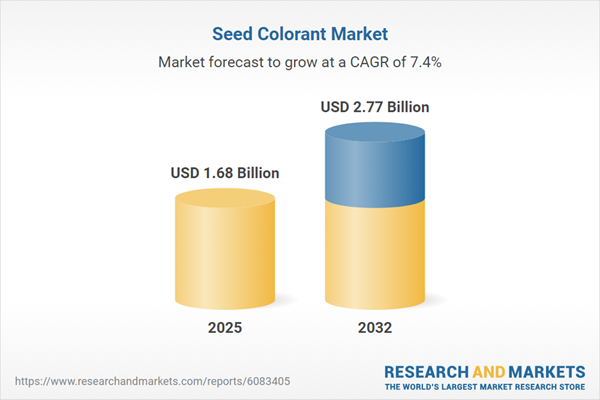Speak directly to the analyst to clarify any post sales queries you may have.
The seed colorant market is evolving quickly as regulatory standards rise, sustainability expectations grow, and agricultural innovations transform how inputs are selected. Senior decision-makers now consider seed colorants indispensable for meeting compliance demands and improving crop management outcomes.
Seed Colorant Market Snapshot
In 2024, the global seed colorant market reached USD 1.56 billion. Projections indicate growth to USD 1.68 billion by 2025 and up to USD 2.77 billion by 2032, reflecting a steady CAGR of 7.43%. The sector is experiencing strong momentum, fueled by demand spanning both large-scale commodity operations and specialty agricultural applications. Compliance requirements, sustainability goals, and the spread of precision agricultural tools all shape this landscape. Regulatory trends and advances in colorant material science are advancing strategies in sourcing, production, and market positioning across all regions.
Scope & Segmentation of the Seed Colorant Market
The seed colorant market encompasses a wide set of segments and global regions, each with distinct operational priorities and adoption drivers.
- Crop Types: Serves cereals & grains, fruits & vegetables, oilseeds & pulses. Each crop group has specific compatibility and colorant application requirements to ensure seed traceability and enhanced protection.
- Forms: Available in liquid and powder formats, supporting both automated facilities and flexible on-farm treatment. Selection aligns with operational needs and equipment integration.
- Colorant Types: Inorganic pigments offer processing stability, while organic dyes appeal to companies prioritizing sustainability initiatives and eco-friendly product lines.
- Treatment Types: Includes formulations with integrated actives for fungicide, insecticide, and nematicide functions. These combination products enable customized pest management and support early crop vigor.
- Technologies: Utilizes both natural and synthetic methods, catering to regulatory frameworks, environmental strategies, and crop-specific performance requirements.
- End Uses: Deployed in commercial farming and home gardening contexts, with tailored usability and compliance measures for each user group.
- Geographic Coverage: Portfolio addresses the Americas, Europe, Middle East & Africa, and Asia-Pacific, recognizing regulatory, climate, and infrastructure variations that shape product adoption and operational protocols.
Key Takeaways for Senior Decision-Makers
- Modern seed colorants now function as multi-purpose tools, advancing product traceability, streamlining compliance, and enhancing efficiency throughout the agribusiness supply chain.
- Innovative materials such as biodegradable carriers and nano-encapsulation address both environmental considerations and the requirement for reliable seed protection.
- Collaborations between agrochemical, biotechnology, and equipment companies are yielding integrated colorant solutions, which improve system compatibility and operational performance.
- Market leaders are responding to regional sustainability standards by adopting plant-based pigments, supporting differentiation and compliance across varied geographies.
- Organizations with agile supply chains gain resilience, achieving stable procurement costs and maintaining quality despite shifting regulatory demands.
- Ongoing research is focused on boosting seed visibility and safety, aligning with sustainability mandates while supporting scalable operations.
Tariff Impact
Forthcoming U.S. tariff changes, effective in 2025, are prompting seed colorant manufacturers to modify procurement and sourcing strategies. Companies are expanding supplier networks, engaging in new regional trade discussions, and adopting recycling measures to manage costs and ensure consistent quality. These actions are reshaping the industry landscape and prompting a realignment of long-term supply chain policies to better address evolving trade and regulatory pressures.
Methodology & Data Sources
The analysis is grounded in primary interviews with executives, colorant formulators, and supply chain leaders. Secondary research draws from industry journals, technical white papers, and comprehensive policy reviews. Triangulation across these sources ensures all findings are validated and actionable for stakeholders.
Why This Report Matters
- Enables structured strategic planning by highlighting emerging technologies, evolving market needs, and regional shifts within the seed colorant sector.
- Equips leaders with critical market intelligence that supports product positioning, risk management, and sustainable growth decisions in a complex operating environment.
- Prepares organizations to address evolving regulatory and customer demands with robust innovation and compliance strategies.
Conclusion
The seed colorant sector is experiencing meaningful operational and technological change. Decision-makers who leverage these insights will be well-placed to manage future market dynamics, ensuring adaptability and continued growth across the global agricultural value chain.
Table of Contents
3. Executive Summary
4. Market Overview
7. Cumulative Impact of Artificial Intelligence 2025
Companies Mentioned
The companies profiled in this Seed Colorant market report include:- Bayer CropScience AG
- BASF SE
- Syngenta AG
- Corteva Agriscience
- Adama Agricultural Solutions Ltd.
- FMC Corporation
- UPL Limited
- Sumitomo Chemical Co., Ltd.
- Nufarm Limited
- Clariant AG
Table Information
| Report Attribute | Details |
|---|---|
| No. of Pages | 199 |
| Published | November 2025 |
| Forecast Period | 2025 - 2032 |
| Estimated Market Value ( USD | $ 1.68 Billion |
| Forecasted Market Value ( USD | $ 2.77 Billion |
| Compound Annual Growth Rate | 7.4% |
| Regions Covered | Global |
| No. of Companies Mentioned | 11 |









